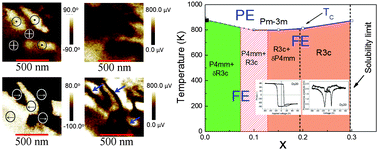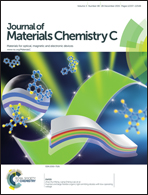Structure and local polar domains of Dy-modified BiFeO3–PbTiO3 multiferroic solid solutions
Abstract
To investigate the effects of dysprosium ions on the crystal structure and multiferroic properties of the bismuth ferrite-based systems, Dy-substituted solid solutions of 0.66Bi1−xDyxFeO3–0.34PbTiO3, with x = 0, 0.05, 0.1, 0.15, 0.2, 0.3, 0.4 and 0.5, have been synthesized and characterized. With increasing concentration of Dy, the crystal structure transforms from a primarily tetragonal P4mm phase to a rhombohedral R3c phase. Moreover, the R3c (or monoclinic Cc) phase is found to coexist with the P4mm phase in the composition range of 0 ≤ x < 0.2, which is attributed to the effect of Dy that favours the rhombohedral structure. Interestingly, the ferroelectric phase transition temperature TC increases with increasing Dy concentration for compositions with x ≥ 0.1. This is explained by the crystal structural effect that compensates the dilution effect of ferroelectrically active Bi3+. Piezoresponse force microscopy (PFM) imaging reveals the formation of 180° polar domains, which can be switched by applying electric fields through the PFM tip, confirming the ferroelectricity. A partial phase diagram is established in terms of composition and temperature. It describes the crystal structure and ferroelectric phases, as well as the solubility limit, of the Bi1−xDyxFeO3–PbTiO3 solid solution system.


 Please wait while we load your content...
Please wait while we load your content...